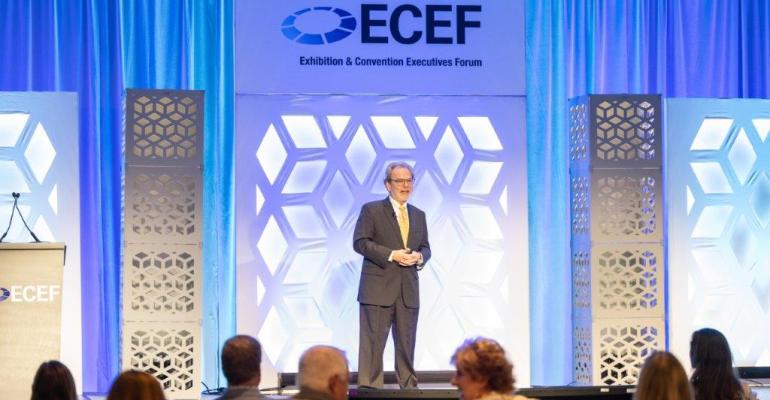Creating a tradition for your event can make the experience more memorable, give it a sense of identity, and provide continuity from year to year. An excellent example of this is the opening session at Lippman Connect’s Exhibition & Convention Executives Forum. Since 2017, event producer Sam Lippman has opened the conference with a “Five Key Data Points in Five Minutes” session, running through statistics or observations that currently define the industry.
On May 29, Lippman kicked off ECEF at the Grand Hyatt in Washington, D.C., with his signature fast-paced report. This year his five points were gleaned from Freeman’s 2024 Exhibitor Trends Report, and he followed his talk with a deeper dive into the findings, joined by Ken Holsinger, senior vice president, strategy, at Freeman.
With the five-minute clock running, here are the five points Lippman shared with ECEF attendees:
1. At-risk exhibitors: According to the Freeman study, 86 percent of large exhibitors said they are securing additional meeting-room space for their organizations. This is a concerning trend, said Lippman, because exhibitors that value taking attendees away from the show floor to private meetings might next consider creating their own corporate events. In fact, the Freeman research shows a 10-percent jump from 2023 to 2024 in exhibitors who say they are already planning their own event or might consider doing so in the future.
2. Exhibitor packages: Another reason companies decide to skip the exhibition experience is because it’s “hard, complicated, and frustrating,” said Lippman. He pointed to Freeman data that shows exhibitors’ top-requested assistance from organizers are “exhibit packages inclusive of all costs” closely followed by “simplified on-site logistics.”
3. Connecting in advance: It’s not surprising that 64 percent of exhibitors want to connect with attendees before a show. But what is interesting, said Lippman, is that an even larger percentage of attendees (68 percent) would like to do so, according to Freeman’s research. He called on organizers to provide the tools to prearrange meetings, which will drive business on the show floor.
4. Attraction is not retention: Freeman’s research into what is most important to show attendees—and will keep them coming back—may not be what organizers are spending their money on, Lippman said. What matters most to attendees are immersive experiences, customized agendas, and technology. Lower priorities are the quality of the food and beverage and after-hours events, and the very lowest priorities are gamification, natural lighting, and wellness activations.
5. Event objectives: According to Freeman’s research, show organizers should reconsider how they analyze their audiences. While they typically consider attendees in terms of industry, gender, age, and socioeconomic factors, it is an attendee’s event objectives—such as learning, networking, doing business, and having fun—that should be the priority. Lippman reviewed a case study in which attendees were asked about their event objectives and whether they wanted a customized agenda based on those objectives. The NPS scores of those who took the custom agenda were 34 percent higher than those who did not.
For more on the Freeman’s 2024 Exhibitor Trends Report, a 60-minute MeetingsNet webinar led by Ken Holsinger is now available on demand.





